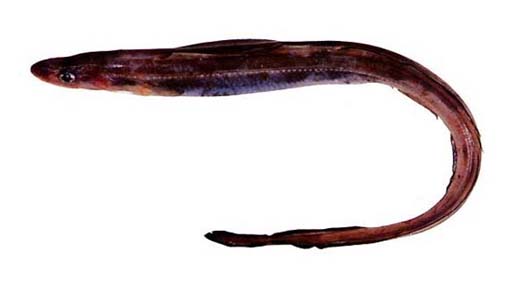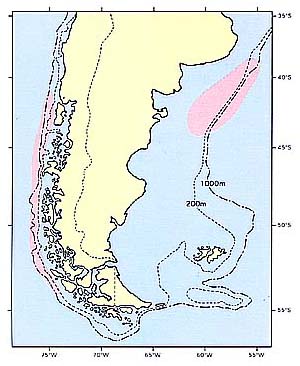アナゴ科
- HOME
- デジタル図鑑
- パタゴニア海域の重要水族
- 硬骨魚綱 ウナギ目 アナゴ科
アナゴ科(Congridae)

5 ラプラタシロアナゴ(Rapurata-shiroanago)
Pseudoxenomystax albescens(Barnard, 1923)
Congrio (Arg.); Bocavante (SA.)
特 徴:
背鰭276〜300軟条,臀鰭183〜213軟条,胸鰭12〜14軟条,側線孔数140〜151。頭長は体長の14.5〜15.5%,眼径は2.1〜2.5%,吻長は4.0〜4.4%,両眼間隔は2.5〜2.9%,上顎長は5.0〜6.0%,胸鰭長は4.8〜5.4%,背鰭前長は14.9〜15.6%,肛門前長は39.8〜42.1%,臀鰭前長は40.4〜43.2%。体は延長して,前半部は円筒形,後半部は側扁する。肛門前長は体高の約5倍,頭長の約3倍。頭は小さくやや縦側し,体長は頭長の約6.5倍。口は小さく伸出不能で上顎後端は眼の中央下に達する。上顎は下顎よりわずかに前方に突出する。口を閉じても,上顎上の歯帯は見える。口唇は肉厚。眼は中庸で,眼径は両眼間隔よりわずかに小さい。小円錐歯は両顎と鋤骨で歯帯を形成する。口蓋骨は無歯。鰓孔は小さく,長さは左右のものの距離の半分。鼻孔は左右に2個ずつ,前鼻孔は管状で吻端より眼に近く位置する。背鰭起部は胸鰭起部の上方に位置する場合が多いが,一定しない。臀鰭起部は体中央部よりわずかに前方に位置する。胸鰭は小さく,直下に鰓孔が位置する。腹鰭はない。尾鰭先端は丸味を帯び,尾鰭は背鰭および臀鰭と連続し,明確ではない。鱗は存在しない。体全体を絨毛がおおう。側線はよく発達し,鰓蓋部から尾鰭基部まで直線状に斜走する。側線孔は管状でよく発達する。少くとも全長1mには達する。
分 布:
チリ パタゴニアとアルゼンチン パタゴニアの陸棚から陸棚斜面に広く分布する。地中海,熱帯大西洋および南アフリカの深海からも知られている(Smith, 1977)。
備 考:
チリ側とアンゼンチン側から得られた標本を比較して,両者にわずかな肥満度や色彩の違いを感じたが,現在のところ,それが亜種や種の違いに相当するものかどうかつきとめるに至らなかった。この点将来の研究が必要である。
(中村 泉)
Material examined:
5 from Chile (795.0-812.0 mm TL), FAKU CP 77, 331, 332, 774, 861.
Description:
D 276-300; A 183-213; P1 12-14; LL pores 140-151.
HL 14.5-15.5% of SL; ED 2.1-2.5; SN 4.0-4.4; IO 2.5-2.9; UJ 5.0-6.0; P1L 4.8-5.4; PreD 14.9-15.6; PreAn 39.8-42.1; PreA 40.4-43.2.
Body elongate, round anteriorly and compressed posteriorly. Depth of body about 5, head length about 3 in distance between snout to anus. Head, rather depressed and small, about 6.5 in total length. Mouth small, end of upper jaw reaching to middle of eye. Upper jaw slightly longer than lower jaw. A patch of premaxillary teeth visible, even when mouth closed. Lips rather thick and fleshy. Eye moderate in size, slightly smaller than interorbital width. Small conical teeth in band on jaws and vomer. No teeth on palatine. Gill-slit small, about half as wide as interspace. Two nostrils, anterior one tubular and situated nearer to eye. Dorsal fin originating above origin of pectoral fin. Anal fin originating slightly anterior to middle of body. No scales. Fine soft cilia densely covering body. Lateral line distinct, running almost straight from above operculer region to tail with many tubular lateral line pores. Brownish dorsally, lighter below, dorsal and anal fins with dark margin.
Distribution:
Continental shelf and slope of Chilean Patagonia and off Atlantic coast of South America from Mar del Plata to Peninsula Vardes.
Remarks:
It is likely that further comparison between Chilean and Argentine populations may separate this species into two subspecies. The meat of this fish is said to be excellent in fresh condition (Bellisio, López and Torno, 1979).
(Izumi NAKAMURA)

Distribution of Pseudoxenomystax albescens in Patagonia.

Fine soft cilia (1) and lateral line pore (2) on skin.
- 1
- 2